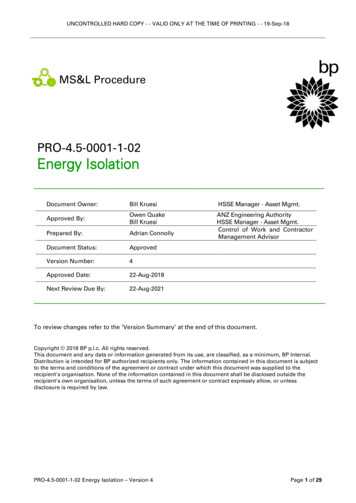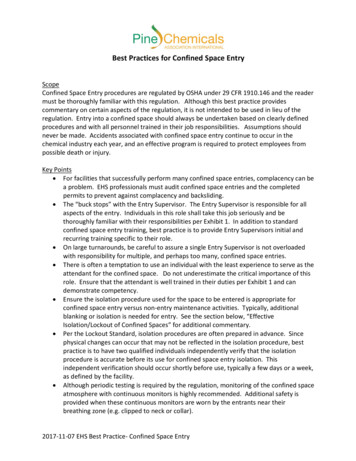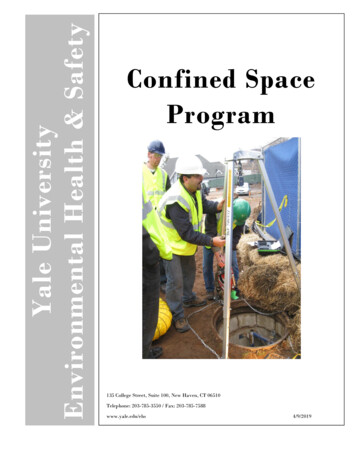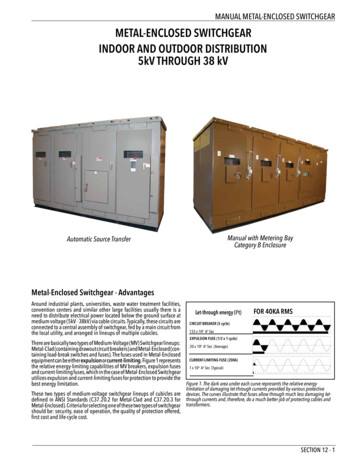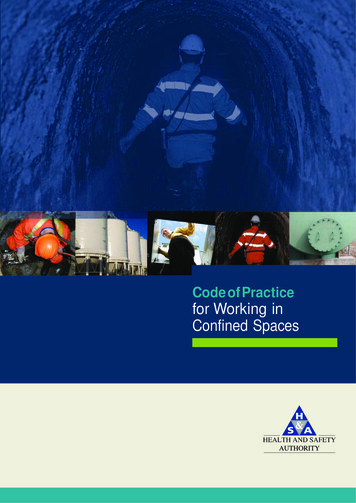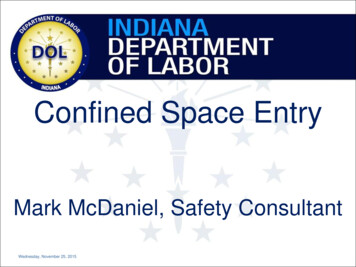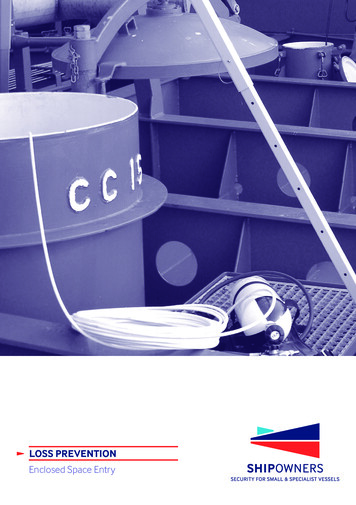
Transcription
LOSS PREVENTIONEnclosed Space Entry
ContentsChapter 1 Introduction 2Chapter 2 Enclosed Spaces and Associated Hazards 4Chapter 3 Enclosed Space Entry Procedures 6Risk Assessment 7Authorisation of entry 7Securing the space 8Ventilation 9Testing the atmosphere 9Checks prior to entry 11Precautions during entry 17Checks upon completion of job 17Chapter 4 Drills, Training and Emergency Procedures 18Chapter 5Safety Management Systems 21Chapter 6:Case Studies 22Case Study 1 22Case Study 2 23Case Study 3 25Chapter 7Appendix 27Chapter 8Acknowledgements 32Loss Prevention – Enclosed Space Entry I 1
Chapter 1 IntroductionIn 2007 we published a booklet highlighting the correct procedures for Enclosed SpaceEntry. At the time the Club was experiencing a number of claims where people had sadlylost their lives by not following procedures properly. However, today similar incidents arestill taking place. At Shipowners’ we want to ensure our Members are protected from anyeventuality. With this in mind and the fact that the ‘International Maritime Organisation’has recently rolled out a number of initiatives around enclosed space entry, we haverevised and updated our Enclosed Space Entry booklet.In most cases enclosed space incidents on board ships are caused by an insufficientknowledge of, or disregard for taking precautions. Studies have shown that those involvedin the majority of these incidents were not suitably trained, experienced in making enclosedspace entries or aware of the associated dangers. There have even been instances wheresuitably trained and experienced personnel have been involved in such incidents, ashighlighted in Chapter 6 (Case Studies).When seeing a colleague collapsed within an enclosed space it is a natural and impulsivereaction to rush in and help. Unfortunately, this is one of the main causes of fatalities.Over 50% of workers who die in confined spaces are attempting to rescue colleagueswho have found themselves in difficulty. It is essential to remember that when facedwith such a serious dilemma, it is hard to think rationally. This is why it is important toprepare correctly. It cannot be overemphasised how important performing thorough riskassessments, evaluations, training and drills are in preparation for enclosed space entry.2 I Loss Prevention – Enclosed Space Entry
Prevention is better than cure. To reduce the possibility of an incident, notwithstandingthe type of vessel or the relevance to the ISM Code, written procedures for entry intoenclosed spaces should be established, giving all persons making an enclosed space entryinstructions to adhere to. Once these procedures have been implemented, no entries areto be undertaken without compliance.Figure 1: Warning notice displayed on the entrance to an enclosed spaceLoss Prevention – Enclosed Space Entry I 3
Chapter 2 Enclosed Spaces andAssociated HazardsEnclosed space, as defined by IMO Resolution A.1050(27), means a space which has anyof the following characteristics: limited openings for entry and exit; inadequate ventilation; and is not designed for continuous worker occupancy,and includes, but is not limited to: cargo spaces, double bottoms, fuel tanks, ballast tanks,cargo pump-rooms, cargo compressor rooms, cofferdams, chain lockers, void spaces,duct keels, inter-barrier spaces, boilers, engine crankcases, engine scavenge air receivers,sewage tanks, and adjacent connected spaces.With reference to the above, an ‘adjacent connected space’ means a normally unventilatedspace which is not used for cargo but which may share the same atmospheric characteristicswith the enclosed space such as, but not limited to, a cargo space accessway.To identify enclosed spaces a list should be produced bespoke to each vessel. This shouldbe produced by using risk assessment and continuous review. It should also be noted thatwhile some enclosed spaces may be easy to identify, others may be less obvious, thoughequally dangerous. To complicate matters, some spaces may be dangerous only temporarily– perhaps due to the type of cargo being carried or work to be undertaken, such as acompartment during spray painting.On ships where entry into enclosed spaces is uncommon, the dangers may be lessapparent and therefore these may need increased vigilance and crew training.The possible hazards associated with an enclosed space include:1. Oxygen deficiencyAn empty tank or confined space may become deficient in oxygen if kept closed for a longtime due to corrosion. Other factors that contribute to oxygen depletion are activitiessuch as welding, gas cutting, painting, the presence of oxygen absorbing chemicals orcargoes, displacement of oxygen by other gases such as hydrogen, inert gases, carbondioxide or other fire extinguishing media and gases released from volatile cargoes.4 I Loss Prevention – Enclosed Space Entry
2. Oxygen-enriched atmosphereSince oxygen aids combustion, an oxygen enriched compartment greatly increases the riskof fire, spontaneous combustion and/or explosion. Oxygen is colourless, odourless and hasno taste. Hence an oxygen enriched atmosphere cannot be detected by normal humansenses. Oxygen also does not give any physiological effects which could alert personnelto the presence of oxygen enrichment. Some of the factors that could lead to oxygenenrichment are leaking or damaged hoses, pipes, valves, excess use of oxygen in welding,flame cutting or similar processes.3. ToxicityA. Due to liquid bulk – This includes liquid petroleum and chemicals carried in bulk.Hydrocarbon gases are toxic and may be present in fuel or cargo tanks that havecontained petroleum or its products. Similarly the vapours of some chemical cargoes,such as hydrogen sulphide, are highly toxic too. These gases may also be present inthe pump rooms, cofferdams, duct keels or other spaces adjacent to cargo tanks if thecargo has leaked. Due to the enormity of the cargoes carried in liquid bulk form andthe inherent dangers posed by each, particular care should be taken and cases shouldbe dealt with on an individual basis.B. D ue to solid bulk – A toxic atmosphere may develop in cargo spaces of ships carryingsolid bulk cargoes due to the nature of the cargoes. Care should be taken when enteringsuch spaces and suitable references to the shipper’s declaration and the InternationalMaritime Solid Bulk Cargoes (IMSBC) Code are to be made.C. D ue to dangerous goods in packaged form – Cargo spaces carrying dangerousgoods in packaged form may be subject to a toxic atmosphere due to the nature of thecargo carried. In such a scenario, reference to the relevant sections of the InternationalMaritime Dangerous Goods (IMDG) Code and the Emergency Procedures for ShipsCarrying Dangerous Goods (EMS) should be made.D. O thers – Ship board activities such as painting, chemical cleaning and fumigation,may also create a toxic atmosphere.4. FlammabilityFlammable liquids, gases or combustible dusts can create an explosive/flammableatmosphere within an enclosed space. If ignited, these could lead to fire or explosion.Some of the contributing factors to this could be an oxygen enriched space, a spacecarrying cargoes that emit volatile vapours or introduction of chemicals such as paintsin an enclosed space which would effectively complete the fire triangle.Loss Prevention – Enclosed Space Entry I 5
Chapter 3 Enclosed Space Entry ProceduresThe Club has published the following guidelines to complement procedures establishedby our Members for enclosed space entries and to assist Members, who do not have theirown procedures, to create their own. All Members, even if entries into enclosed spacesare infrequent on board their vessels, should have a checklist for entering into enclosedspaces forming part of their laid down procedures. These recommendations may not beapplicable to all vessels and circumstances but are intended to be used as a general guideto demonstrate good practice from which specific guidelines/procedures can be drawn up.When drafting and developing enclosed space entry procedures reference should also bemade to: T he United Kingdom’s MCA (or home countries equivalent authority) ‘Code of SafeWorking Practices’, Chapter 15 (of the 2015 edition). U nited Kingdom’s Merchant Shipping (Entry into Enclosed Spaces) Regulation 1988(SI. 1988–1638). I MO Resolution A.1050(27), Revised Recommendations For Entering Enclosed SpacesAboard Ships. Flag Administration/local regulations as may be applicable.Figure 2: Entry tag displayed on entrance to enclosed space. This summarises that thespace has been passed for entry by a competent/responsible person.6 I Loss Prevention – Enclosed Space Entry
Risk AssessmentIn addition to the risk assessment undertaken while compiling a list of enclosed spaces onboard a ship (as highlighted in Chapter 2), before any entry into an enclosed space, anotherrisk assessment should be carried out of the space by a competent person1. Such anassessment should take into account various factors such as last cargo carried, ventilationof the space and should be undertaken with an aim of establishing whether there are anypotential hazards in the space. The assessment should be carried out with the assumptionthat the space to be entered is hazardous until established otherwise.On smaller vessels such as barges and vessels operating specifically in and around harbours,a competent person and/or the relevant equipments may not be available on board.In such cases, no attempt should be made to enter into enclosed spaces until an appropriateassessment has been carried out and proper procedures established.Assessment of the space and identification of the hazards should be undertaken even whenthe entry is being carried out by a third party such as a surveyor. To ensure safe entry therisk assessment should be undertaken by the competent person who should be fully awareof the vessel’s characteristics or special circumstances that may effect safe entry.Procedures for entering into an enclosed space need to be adopted once the riskassessment has been carried out and hazards and their severity have been identified.Authorisation of entryIt should always be remembered that anyone has the right to refuse to enter any compartmentthat they question the safety of.No entry into an enclosed space should be made without being authorised by the Masteror the nominated responsible person2.Before entering an enclosed space a ‘Permit to Work’ system should be in place.The Master or the nominated responsible person authorising the entry should be satisfiedthat all aspects of the ‘Permit to Work’ are complied with and that regular checks are inplace to continuously monitor the space prior to authorising entry.1 Competent person means a person with sufficient theoretical knowledge and practical experience to make aninformed assessment of the likelihood of a dangerous atmosphere being present or subsequently arising in the space.2 Responsible person means a person authorised to permit entry into an enclosed space and having sufficientknowledge of the procedures to be established and complied with on board, in order to ensure that the spaceis safe for entry.Definition provided by IMO Resolution A.1050(27).Loss Prevention – Enclosed Space Entry I 7
Securing the spaceIt is imperative to ensure that the entrance to an enclosed space is secured against accidentalentry. This is especially important when a door or an access is left open to provide for naturalventilation. An open door or access could be mistaken for an indication that the space issafe to enter and therefore the entrance needs to be suitably cordoned off by use of amechanical barrier and/or warning signs displayed at the entrance, as well as other prominentlocations on the vessel. If possible, an attendant is to be stationed at the entrance.When preparing a space for entry, it needs to be isolated by means of lock out/tag outprocedure to ensure that the space is taken out of service. This can be attained by isolatingelectrical sources, hydraulic systems, valves, piping systems and placing adequate warningsigns at locations where controls of the above mentioned may be present. Referenceshould be made to vessel systems drawings to ensure that the isolation is absolute.Figures 3 and 4: Warning signs displayed on a valve and at the control station8 I Loss Prevention – Enclosed Space Entry
VentilationBefore entering any enclosed space it should be sufficiently ventilated. Ventilation shouldbe carried out by releasing as many openings as possible, preferably with at least oneopening at each end of the relevant space.Ventilation should ideally be carried out for a minimum of 24 hours prior to entry; howeverthis may not always be the case, especially when the entry into an enclosed space is notscheduled. In such cases, efforts must be made to ventilate the space for the maximumperiod possible to ensure the space is safe for entry. It is important that the ventilation iscontinuous as a hazardous atmosphere may form again once the air flow is stopped. If theventilation system fails, all persons in the enclosed space must immediately evacuate the space.It is preferable to use forced ventilation as opposed to natural ventilation if the vessel isprovided with mechanical blowers or fans. Natural ventilation can be assisted by usingsails or cowls to direct the air flow into the space. Natural ventilation is most efficient onlywhen at least two accesses are open (preferably at each end) to allow a through draft ofair. It is important to note that, whether mechanical or natural ventilation is used, the airintake should be placed in an area that will draw in fresh air only. Any vented gases shouldbe discharged away from the area, so as not to contaminate the vicinity.Testing the atmosphereBefore entry and at regular intervals thereafter until all work is completed, the atmosphereof the space must be tested using properly calibrated instruments. These should only beused by persons trained specifically in the use of the equipment. Forced ventilation must bestopped during testing (preferably 10 minutes before testing). Where appropriate, thetesting of the space should be carried out at as many different levels as is necessary toobtain a representative sample of the atmosphere in the space. In some cases it may bedifficult to test the atmosphere throughout the enclosed space without entering thespace (e.g. the bottom landing of a stairway). The use of flexible hoses or fixed samplinglines, which reach remote areas within the enclosed space, may allow for safe testingwithout having to enter the space.It should be emphasised that the enclosed space may also have pockets where atmospheremay be unsuitable. This can be caused by various factors such as cargo residue or tank structureand therefore, although the atmosphere may have been tested and deemed as beingsuitable for entry, due caution must be exercised.It is important to note that the IMO Resolution A.1050(27) – ‘Revised RecommendationsFor Entering Enclosed Spaces Aboard Ships’ states various steady readings for entry purposes,Loss Prevention – Enclosed Space Entry I 9
which if not met, would require additional ventilation and re-testing of the atmosphereafter a suitable interval.It is often assumed that by de-ballasting a tank, a full air change is consequently introducedbut this procedure does not guarantee a safe atmosphere and testing is still required.An empty ballast tank could be oxygen deficient due to internal corrosion.SOLAS regulation (XI-1/7) makes it mandatory, on applicable vessels, to carry an appropriateportable atmosphere testing instrument or instruments. This regulation comes into forcein July 2016.When selecting a portable atmosphere testing instrument for enclosed spaces, referenceshould be made to MSC.1/Circ. 1477 (Guidelines to facilitate the selection of portableatmosphere testing instruments for enclosed spaces as required by SOLAS regulationXI-1/7). The resolution states, amongst other requirements, that the instrument shouldbe capable of measuring and displaying concentrations of: Oxygen; Flammable gases or vapours (% of Lower Explosive Limit); Carbon monoxide; and Hydrogen sulphide.Figure 5: Testing the atmosphere of the enclosed space10 I Loss Prevention – Enclosed Space Entry
Checks prior to entryIn addition to securing and isolating the space, carrying out ventilation and testing theatmosphere, the following are to be determined prior to entering an enclosed space:1) Is there sufficient rescue and resuscitation equipment available at the enclosedspace entrance?If a person in an enclosed space encounters difficulties and has to be rescued, this has tobe carried out as quickly as possible since survival time in such circumstances is very limited.In particular, on tankers and other vessels carrying flammable products, all equipmentshould be of an approved type and also be Intrinsically Safe. To speed up a rescue it isimperative that the safety equipment is readily available at the entrance to the space.This should include, but not be limited to: SCBA (Self Contained Breathing Apparatus) with a fully charged spare cylinder. L ifeline and rescue harness. The lifeline should be of an adequate length and strengthand be detachable in case of entanglement. Torches. Means of hoisting up an incapacitated person, e.g. stretcher (Figure 6). Portable atmosphere testing instruments Resuscitation equipment (Figure 6).Figure 6: Emergency equipment placed at the entrance to enclosed spaceLoss Prevention – Enclosed Space Entry I 11
2) Is there a suitably experienced person in attendance at the entrance?Both before and during the entry into an enclosed space it is crucial to ensure that anattendant1 remains at the entrance. In no circumstances should the attendant movefrom his/her station until all persons have exited the space and the space has beensecured against entry.Figure 7: Attendant at location (regular atmosphere tests are taken to monitorthe environment in the enclosed space)1 Attendant means a person who is suitably trained within the safety management system, maintains a watch overthose entering the enclosed space, maintains communications with those inside the space and initiates theemergency procedures in the event of an incident occurring. Definition provided by IMO Resolution A.1050(27).12 I Loss Prevention – Enclosed Space Entry
3) Have communication arrangements been agreed between the attendantand those entering?The means of communication between the person(s) entering the tank, the nominatedattendant, competent person, responsible person, Master and any relevant persons inthe engine room/bridge should be established and tested prior to entry into the tank.A pre-arranged schedule of how often communications need to be made should beagreed between parties to ensure regular communications are maintained.Communication should be made using the appropriate means, such as physical communicationusing a pre-arranged number of tugs on a lifeline or audible communication using handheldradios of an approved type (intrinsically safe on tankers). In the event that lifelines are rigged,they should be long enough for the purpose and capable of being firmly attached to theharness, but the wearer should be able to detach them easily should they become tangled.4) Is there safe access and sufficient lighting?Sufficient and suitable lighting should be rigged as far as possible and where practicable.Whenever possible, natural lighting should be provided in the tank during inspection byopening all tank hatches. If lighting in the space is not adequate it is advised to carry afully charged, approved torchlight into the space.5) What personal protective equipment (PPE) is to be used?The protective equipment required will differ from case to case. This is because it dependson the risk assessment which will be different for each enclosed space entry.Basic equipment (all to be of approved type) may include: Hard hat, with chin strap. Gloves. Goggles/protective eyewear. Ear defenders. Intrinsically safe torch. Protective footwear. Overalls (protective clothing). A n ELSA (Emergency Life Support Apparatus), EEBD (Emergency Escape BreathingDevice) or other emergency escape breathing device - The EEBD and other similarLoss Prevention – Enclosed Space Entry I 13
emergency escape sets such as an ELSA (see Scott Health & Safety Ltd,www.scottsafety.com) should not be considered as a SCBA. They are designed toenable escape from a hazardous environment by providing a limited supply of airdelivered via a plastic hood or mask. It should be borne in mind that these devicesmust not be used as a means to enable the entry into the enclosed space as itsintended purpose is to enable the user to exit a space safely, should the atmospherebecome oxygen deficient or if hazardous gases are released. P ersonal Gas Monitoring Equipment - This equipment is designed for personal useonly; to provide a warning against oxygen deficiency, toxic gases and explosiveatmospheres whilst the wearer is in the space. Personal gas monitoring equipmentshould not be used as a means of determining whether a space is safe to enter.Figure 8: ELSA sets in use14 I Loss Prevention – Enclosed Space Entry
Figure 9: EEBD positioned in the engine roomIf the atmosphere in the enclosed space is classed as unsafe or suspect, following riskassessment, the space should only be entered when no practical alternatives exist. Thisshould only be for further testing, essential operation, safety of life, or safety of the ship.Breathing apparatus should always been worn during such an entry and the number ofpersons entering the space should be kept to the minimum needed to perform the work.Breathing equipment may be bulky and limit movement in the space. Before entry ispermitted, checks should be made to make sure entry with breathing apparatus is possibleand there is no difficulty in moving within the space or in rescuing an incapacitated personfrom the space.All crew members should be trained in the use of the breathing apparatus. This can be ensuredby performing regular safety drills and including it in the on board training procedures.When the responsible person is allocating personnel for the entry, the proficiency ofusing breathing apparatus should be taken into account. The competent/responsibleperson and the person wearing the breathing apparatus should undertake the fullpre-donning checks as recommended in the manufacturer’s instructions.It should be borne in mind that when using breathing apparatus in stressful emergencysituations the air consumption is greatly increased and thus the duration of the air availableis decreased.Loss Prevention – Enclosed Space Entry I 15
6) Is a ‘Permit to Work’ in place?A ‘Permit to Work’ (enclosed space entry permit) should be completed for each and everyenclosed space entry as it serves as both a check and a record that all necessary measureshave been properly carried out and are in place for the intended entry. A copy of the permitmust be placed outside the entry point. The permit should be as relevant and accurate aspossible. On expiry of the permit all persons should leave the space and re-entry shouldnot be made until another permit has been issued. The permit should be completed andsigned by all appropriate parties concerned.The points below detail broader items that a ‘Permit to Work’ should cover. Additionalpoints may be added specific to the space being entered as required: L ocation, type of work, details of participating crew, responsible person, attendant andvalidity period of the permit (this should never exceed 24 hours). N ature and results of the preliminary tests carried out and the measures undertakento minimise the risks and make the job safe. Details of ventilation and confirmation that continuous ventilation would be maintained. Results of the testing of the atmosphere. Details of the rescue and resuscitation equipment positioned. C onfirmation that all personnel are wearing correct personal safety equipment ofapproved types including confirmation of testing of the equipments and that relevantpersonnel are competent in their use (e.g. breathing apparatus). It should beremembered that when using breathing apparatus in stressful emergency situationsthe air consumption is greatly increased and thus the duration of the air available isdecreased. Space and access illuminated as far as possible. Suitable communication system set up between all parties involved.16 I Loss Prevention – Enclosed Space Entry
Precautions during entry1. Ensure the space is suitably illuminated.2. A lways wear the right PPE. At no point in time whilst inside the enclosed space shouldany of the PPE be removed.3. V entilation should continue during the period that the space is occupied and duringtemporary breaks. The atmosphere should be re-tested before re-entry after a break.In the event of failure of the ventilation system, any persons in the space should leaveimmediately.4. T he atmosphere should be tested periodically whilst the space is occupied and personsshould be instructed to leave the space should there be deterioration in the conditionsor if an alarm sounds on the personal gas detector.5. Communicate regularly as agreed.6. I f a hazard develops or any personnel in the space feels adversely affected, the workin the space should be stopped and a fresh assessment be carried out includingissuance of a fresh ‘Permit to Work’.7. I n the event of an emergency, the relevant alarm should be raised. Under nocircumstances should the attendant enter the space.Checks upon completion of job1. Upon completion of the job, either in entirety or upon expiry of the permit for the day,the responsible person should ensure that all personnel and equipments are out ofthe space.2. The access to the space should be secured against entry.3. The permit should be closed out and signed off.4. All systems that had been locked/tagged out, blanked off, etc. to be restored, if applicable.Loss Prevention – Enclosed Space Entry I 17
Chapter 4 Drills, Training andEmergency ProceduresSOLAS Regulation III/19 makes it mandatory1 that crew members with enclosed spaceentry or rescue responsibilities shall participate in an enclosed space entry and rescuedrill to be held on board the ship at least once every two months.Enclosed space entry and rescue drills should be planned and conducted in a safe manner,taking into account, as appropriate, the guidance provided in the recommendationsdeveloped by the Organization as adopted by Resolution A.1050(27).Each enclosed space entry and rescue drill shall include:1. checking and use of personal protective equipment required for entry;2. checking and use of communication equipment and procedures;3. checking and use of instruments for measuring the atmosphere in enclosed spaces;4. checking and use of rescue equipment and procedures; and5. instructions in first aid and resuscitation techniques.These drills will assist in assessing whether pre-defined contingency plans are suitableand ascertain how effectively they fare with different scenarios. They should be made asrealistic as possible by using appropriate spaces where such incidents are likely to occur.It is important to remember that each vessel may have its unique problems or characteristicswhich may affect the rescue operation and therefore all procedures must be vessel specific.To add to the realism, a dummy of estimated weight and size should be used as a victim.All drills must be recorded appropriately. If a full muster, drill or training session is not heldat the scheduled time, an entry shall be made in the log-book stating the circumstancesand the extent of the muster, drill or training session held.Every crew member shall be given instructions on risks associated with enclosed spacesand on board procedures for safe entry into such spaces. Such instructions should assistthe crew members in identifying the applicable spaces and their associated problems,including the nature of activities, which may cause an unsafe atmosphere to be present.1 For vessels entered with the Club to which SOLAS does not apply, please refer to our bulletin titled “Advice forvessels below 500GT on the benefits of adopting ship-specific procedural systems” at edural-systems18 I Loss Prevention – Enclosed Space Entry
Figure 10: Enclosed space drill and training in progress to familiarize crew memberswith procedures and associated equipmentIn the event of an emergencyIn the event of an emergency the vessel’s crew must follow the emergency proceduresdetailed on how to respond to the situation. No one should enter any space where theatmosphere is suspect to attempt a rescue without taking suitable precautions for theirown safety. Failure to do so will put the would-be rescuer’s life at risk along with thecasualty’s chances of survival. Many fatalities have occurred as a result of individualsattempting a rescue in enclosed spaces without taking adequate precautions.Under no circumstances should the attendant enter the space. Once help has arrived,the situation should be evaluated and the rescue plan put into effect. If the casualty isunconscious it must be assumed that the atmosphere in the space is unsafe and therescue team must not enter unless wearing adequate safety equipment including abreathing apparatus. The attendant should remain outside the space at all times toensure the safety of those entering the space to undertake the rescue.Loss Prevention – Enclosed Space Entry I 19
The following illustrates some areas to be covered by the vessel’s emergency plans, but itshould be noted that this is not exhaustive: T he composition and duties of the perso
Chapter 4 Drills, Training and Emergency Procedures 18 Chapter 5 Safety Management Systems 21 Chapter 6: Case Studies 22 Case Study 1 22 Case Study 2 23 Case Study 3 25 Chapter 7 Appendix 27 Chapter 8 Acknowledgements 32. 2 I Loss Prevention - Enclosed Space Entry In 2007 we published a booklet highlighting the correct procedures for Enclosed Space Entry. At the time the Club was .



